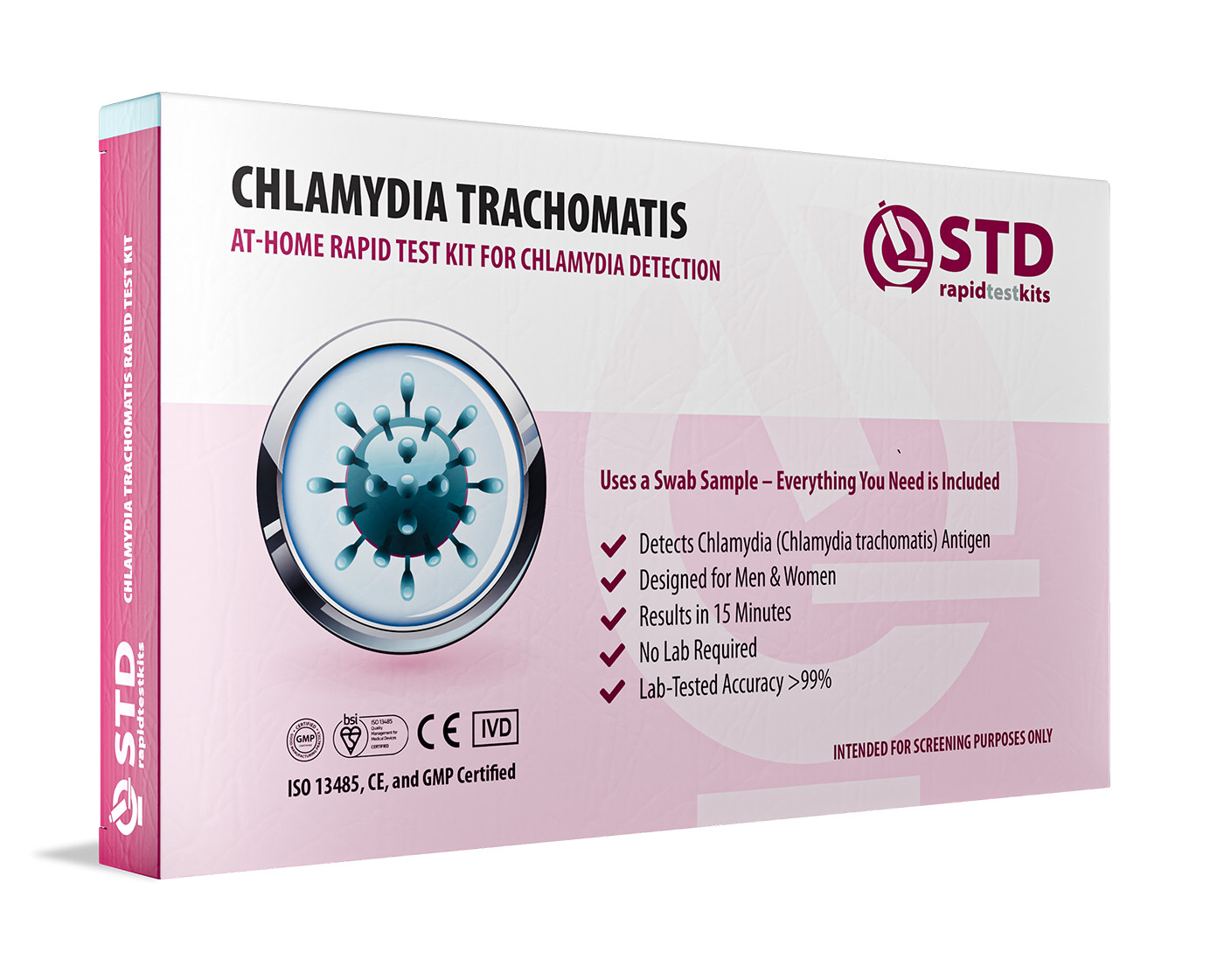The Growing Demand for Private STD Testing
Why Chlamydia Is America’s #1 STD
Chlamydia is the most reported sexually transmitted disease in the United States, and has been for over two decades. That’s not just a statistic. It’s a warning.
Each year, the Centers for Disease Control and Prevention (CDC) logs over 1.6 million new cases of chlamydia, and that’s just the ones that get reported. Experts believe the real number is likely closer to 3 million, because most people never experience symptoms, or never get tested.
This infection thrives in silence. It doesn’t cause visible sores like herpes. It doesn’t burn like gonorrhea always does. It sneaks in, multiplies, damages your reproductive organs, and often leaves you completely unaware until the consequences show up: pelvic pain, infertility, miscarriage, or a partner blindsiding you with a diagnosis of their own. So why aren’t we screaming about it?
Because chlamydia has a branding problem. It’s seen as “the easy one.” The common one. The one you can cure with a round of antibiotics, no big deal. But make no mistake: chlamydia is no joke. And when you factor in delayed diagnosis, reinfection, partner shame, and medical gaps? You’ve got a full-blown crisis that nobody’s talking about. Until now.

What Is Chlamydia, Really? Don’t Let the Simplicity Fool You
Let’s get scientific for a second. Chlamydia is caused by a bacterium called Chlamydia trachomatis. It infects the mucous membranes of the genitals, rectum, throat, and even the eyes. Yes, eyes. That’s how aggressive this little bug can be.
What makes chlamydia so sneaky is its incubation period. You can be infected and contagious for 1 to 3 weeks before any symptoms show up, if they show up at all. During that time, you could be passing it to partners without even knowing.
And here’s where it gets worse:
Chlamydia doesn’t just chill in your body and then leave. If untreated, it climbs. In women, it can travel up the cervix into the uterus and fallopian tubes, causing pelvic inflammatory disease (PID). In men, it can inflame the epididymis, the tightly coiled tube that stores sperm, leading to testicular pain and, yes, infertility.
But for many people, the infection leaves no clues. No pain. No discharge. No reason to panic. That’s why chlamydia gets passed around in dorm rooms, bedrooms, sex parties, marriages, and committed relationships without detection. It’s not about being reckless. It’s about being unaware. And that’s exactly what chlamydia counts on.
Chlamydia Symptoms: The Ones You Miss Until It’s Too Late
Chlamydia is often called “the silent infection” for a reason, up to 70% of infected women and 50% of infected men never experience symptoms. But silence doesn’t mean safety. While you’re walking around symptom-free, the bacteria is spreading, climbing, and potentially doing permanent damage to your reproductive system. For those who do get symptoms, they tend to be subtle, slow, and easily misdiagnosed as something else.
Chlamydia in Women
Here’s what it might look like:
- Unusual vaginal discharge (often yellowish or milky)
- Burning while peeing
- Pain during sex
- Bleeding between periods
- Lower abdominal pain
- Painful menstruation
But these can all be mistaken for a yeast infection, UTI, or hormonal changes. Many women only find out they’re infected when a partner tests positive or they experience serious complications like PID or ectopic pregnancy.
Chlamydia in Men
Men have it easier when it comes to detection, if symptoms show up, they’re harder to miss:
- Penile discharge (typically white, cloudy, or yellow)
- Burning with urination
- Pain or swelling in one or both testicles
- Rectal discharge or bleeding (if contracted through anal sex)
Still, many infected men feel nothing until long after they’ve passed the infection on.
Oral and Rectal Infections
Chlamydia isn’t just a genital problem. Oral sex can lead to throat infections, which usually have no symptoms but can still be transmitted. Receptive anal sex can cause rectal chlamydia, which may lead to:
- Discharge from the anus
- Rectal pain
- Bleeding
- A sense that you constantly need to poop
Think you’re safe just because your genitals feel fine? Think again.
Order Now $33.99 $49.00 Check Your STD Status in Minutes
Test at Home with Remedium
Chlamydia Test Kit




How You Catch It, And Why Protection Isn’t Always Enough
Chlamydia doesn’t require deep penetration, marathon sex, or multiple partners. All it takes is skin-on-skin contact with infected fluids. Here’s how it spreads:
- Vaginal or anal sex without a condom
- Oral sex with someone who has it in their throat
- Sharing sex toys that haven’t been cleaned
- Touching infected fluids, then touching your own genitals or eyes
Even one sexual encounter with an infected person can transmit chlamydia.
What About Condoms?
Condoms and dental dams reduce your risk, but they’re not perfect. If they break, slip off, or don’t cover the infected area, you’re still exposed. And most people don’t use protection for oral sex, which leaves a big loophole in prevention.
Non-Sexual Transmission? Rare, But Possible
Chlamydia is not spread by hugging, kissing, toilet seats, or towels. But eye infections can happen if contaminated fluids reach the eye, yes, even by accident. This is most common in newborns born to infected mothers, which is why prenatal screening is essential.
Bottom line: If you’re sexually active, you’re at risk. And the only way to know for sure? Test. Every. Time.
Chlamydia Complications: From Fertility to Full-Body Damage
Here’s where chlamydia stops being a “nuisance STD” and starts becoming a health threat that can change your life. When left untreated, this bacteria doesn’t just sit quietly, it climbs. And once it spreads beyond your genitals, the damage gets serious, fast.
For People With Vaginas: The Slow March Toward Infertility
If you have a cervix, untreated chlamydia can cause pelvic inflammatory disease (PID), an infection that affects the uterus, fallopian tubes, and ovaries. PID is no joke. It can:
- Cause chronic pelvic pain
- Lead to scar tissue that blocks your fallopian tubes
- Increase your risk of ectopic pregnancy (a life-threatening condition)
- Make it harder, or impossible, to conceive
An estimated 1 in 8 women with a history of PID caused by chlamydia will struggle with infertility. And many of them never knew they had it in the first place. Even worse? Some PID cases are completely asymptomatic. That’s right, you can develop permanent reproductive damage without ever realizing you were infected.
For People With Penises: It’s Not Just Discharge Anymore
Untreated chlamydia in men can lead to epididymitis, a painful condition that affects the coiled tube that stores sperm. Symptoms include:
- Testicular pain or swelling
- Fever
- Painful ejaculation
- Blood in semen
While not as common as PID in women, epididymitis can cause male infertility, especially when both testicles are affected or the infection goes untreated for too long. There’s also prostatitis, an inflammation of the prostate gland that can result from untreated chlamydia. It can cause long-term urinary issues and sexual dysfunction.
Reactive Arthritis: When Chlamydia Spreads Beyond Your Genitals
In some people, chlamydia triggers an autoimmune reaction called reactive arthritis (Reiter’s syndrome). This leads to:
- Joint inflammation
- Eye irritation
- Urethral inflammation
It’s more common in men and can linger for months after the initial infection is gone. Yes, chlamydia can leave behind lasting health issues even after treatment.
Pregnancy Complications
Pregnant while infected? Chlamydia can be passed to the baby during delivery, causing:
- Eye infections (conjunctivitis)
- Pneumonia in newborns
- Preterm birth or low birth weight
This is why prenatal STD testing is critical, and why chlamydia is automatically screened for during early pregnancy in many countries.

Why Chlamydia Keeps Spreading: Shame, Silence, and Missed Diagnoses
Here’s the uncomfortable truth: chlamydia isn’t winning because it’s invincible. It’s winning because we’re letting it.
This STD spreads easily not just through unprotected sex, but through shame, silence, and systemic failure. People aren’t getting tested, not because they’re reckless, but because they’re embarrassed, uninformed, or simply unable to access care.
Shame: The Oldest STD Symptom in the Book
Let’s face it, most people don’t want to admit they might have an STD. The word “chlamydia” still carries an ugly stigma, like it’s a dirty secret or proof of irresponsibility. That kind of shame makes people:
- Ignore early symptoms
- Avoid conversations with partners
- Put off testing
- Lie to themselves about their risks
But here’s the kicker: chlamydia doesn’t care who you are. It infects virgins, married folks, college students, new moms, and 60-year-olds alike. The bacteria doesn’t judge. Society does.
Silence in Relationships
Even in committed partnerships, people avoid talking about sexual health. Some don’t want to “ruin the mood.” Others assume fidelity equals immunity.
Newsflash: most chlamydia cases come from people who didn’t even know they were infected. That includes boyfriends, girlfriends, husbands, wives, and long-term partners who’ve never been tested since their last partner, and don’t think they need to be. Avoiding the conversation doesn’t prevent chlamydia. It just keeps it moving.
Medical Gaps and Misdiagnoses
Healthcare systems fail, too. In many clinics:
- Doctors don’t ask about sexual history
- Routine STI screening isn’t offered unless you ask
- Symptoms are dismissed as “just a yeast infection” or “probably a UTI”
- Queer, trans, and BIPOC patients are especially likely to be ignored or misdiagnosed
Plus, in countries without universal healthcare, cost becomes a barrier. People skip testing because they can’t afford the visit, or they’re afraid of being outed on their parents’ insurance.
Sex Education Is Still Trash
And let’s not forget the root of all of this: bad sex ed. Most people don’t know that:
- Chlamydia can affect the throat and anus
- You can be reinfected even after treatment
- Discharge or burning aren’t the only signs
- You can pass it on without ever knowing you have it
If you were taught abstinence or scare tactics and nothing about routine testing, this crisis isn’t your fault, but it is your fight.
Check Your STD Status in Minutes
Test at Home with Remedium3-in-1 STD Test Kit

 For Men & Women
For Men & Women Results in Minutes
Results in Minutes No Lab Needed
No Lab Needed Private & Discreet
Private & DiscreetOrder Now $69.00 $147.00
For all 3 tests
The Test You’re Probably Avoiding (But Shouldn’t Be)
Here’s a wild fact: testing for chlamydia is ridiculously easy. We’re not talking about medieval tools or awkward exams anymore. We’re talking pee in a cup or swab yourself at home and mail it in. That’s it. That’s the whole thing.
And yet, millions of people are walking around infected, because they’re either too embarrassed, too busy, or too uninformed to take the five minutes that could change everything.
How Chlamydia Testing Actually Works
There are two main ways to detect Chlamydia trachomatis:
- Urine test: You pee in a cup. Labs look for the bacteria’s DNA.
- Swab test: A gentle swab of the cervix (for vagina-owners), urethra (for penis-owners), throat, or rectum depending on sexual practices.
No pain. No needles. No drama. If you’re testing at a clinic, results usually take a few days. If you’re testing from home, like with a kit from stdrapidtestkits.com, you can get answers discreetly, without an awkward waiting room or explaining your sex life to a stranger in a white coat.
Who Should Get Tested?
- Anyone sexually active under 25
- Anyone with new or multiple partners
- Anyone with symptoms, even mild ones
- Anyone whose partner tested positive
- Anyone who hasn’t tested in over a year
- Anyone who just wants peace of mind (no shame in that)
It doesn’t matter if you feel fine. It doesn’t matter if your partner swears they’re clean. It matters that you test.
The Biggest Excuses, And Why They’re Bullsh*t
“I don’t have symptoms.”
Cool. Neither do 70% of people with chlamydia.
“I trust my partner.”
Great. Have they been tested since their last partner?
“I’m scared of what I’ll find out.”
Fair. But fear won’t protect your fertility, or your future.
“I don’t want anyone to know.”
Then go the at-home route. No clinic, no questions, no judgment.
What to Do If You Test Positive: Step-by-Step Damage Control
So your test says you’ve got chlamydia. Now what?
- First: breathe.
- Second: remember that chlamydia is curable. Not manageable, not treatable, not “live with it forever”, curable. You’re not doomed. You’re not dirty. But you do need to act fast, smart, and responsibly.
Here’s exactly what to do.
Get Treated Immediately
Chlamydia is typically treated with antibiotics, most commonly:
- A single dose of azithromycin, or
- A 7-day course of doxycycline (twice daily)
No, cranberry juice won’t help. No, garlic doesn’t kill STDs. This is science, not folklore. Follow your healthcare provider’s instructions, and don’t skip doses if you’re on a multi-day course. You’ll usually feel better quickly, but that doesn’t mean the infection’s gone until the meds are fully finished. Think of it like ghosting chlamydia: you’ve gotta commit to the fade.

Don’t Have Sex for 7 Days After Treatment
Even if you feel fine. Even if you’re horny. Even if you’re using a condom. Why? Because it takes a full week for the bacteria to be cleared, and you can still infect someone else during that window. If both you and your partner are infected, wait until both of you are treated and the seven-day period has passed.
Tell Your Partner(s), Yes, Even the Situationships
This one sucks, but it’s necessary. Anyone you’ve had sex with in the last 60 days should be informed so they can get tested and treated too. If you can’t stomach the conversation, many clinics and online platforms offer anonymous partner notification tools. But ghosting them and letting them suffer in silence? That’s not it. Think of it this way: if someone gave you a heads-up, you'd appreciate it.
Get Retested in 3 Months
Even if your symptoms go away. Even if your treatment was perfect. Reinfection is very common, especially if your partner wasn’t treated or you start a new relationship. Most health agencies recommend retesting 3 months after treatment, just to be sure.
Protect Yourself Going Forward
This doesn’t mean becoming celibate or paranoid. It just means:
- Use condoms and dental dams more consistently
- Get tested regularly (every 3-6 months if sexually active with new partners)
- Talk openly about testing with future partners
- Keep a few at-home STD test kits on hand (they’re like fire extinguishers, you hope you won’t need them, but you’ll be glad you have one)
FAQs
1. How do you get chlamydia?
Chlamydia is transmitted through vaginal, anal, or oral sex with someone who has the infection. It can also spread via shared sex toys if they’re not cleaned or covered with a new condom between uses.
2. Can you get chlamydia from kissing or casual contact?
No. Chlamydia cannot be spread through kissing, hugging, toilet seats, or sharing utensils. It requires direct contact with infected genital fluids or mucous membranes.
3. What are the first signs of chlamydia?
Many people show no symptoms at all, but when symptoms do appear, they often include burning during urination, genital discharge, pelvic pain, or testicular swelling. Women may experience abnormal vaginal bleeding.
4. How long can you have chlamydia without knowing it?
You can carry chlamydia for months or even years without any symptoms. This silent incubation is why regular STD testing is so important, even if you feel perfectly healthy.
5. Can chlamydia go away on its own?
No. Chlamydia does not go away without antibiotics. Ignoring it can lead to serious complications like PID, infertility, or chronic pain.
6. How is chlamydia diagnosed?
Through a urine sample or swab test of the genitals, rectum, throat, or eyes (depending on exposure). Home test kits are available and just as accurate as clinic-based tests.
7. What happens if chlamydia is left untreated?
Untreated chlamydia can cause infertility, pelvic inflammatory disease, epididymitis, chronic pain, and increased HIV risk. It can also be passed to newborns during delivery, causing pneumonia or eye infections.
8. Can you get chlamydia again after being treated?
Yes. You can be reinfected if you have sex with someone who hasn’t been treated. That’s why testing your partner(s) and avoiding sex until treatment is complete is crucial.
9. How often should I get tested for chlamydia?
At least once a year if you’re sexually active, or every 3–6 months if you have new or multiple partners. Pregnant people and anyone under 25 are considered higher risk.
10. Is there a way to test for chlamydia at home?
Yes. At-home test kits from providers like stdrapidtestkits.com allow you to test privately, accurately, and discreetly, no clinic visit required.
Order Now $129.00 $343.00 Check Your STD Status in Minutes
Test at Home with Remedium
7-in-1 STD Test Kit




For all 7 tests
Don’t Be Another Statistic: Your Next Move Starts Here
You’ve made it to the end. And now you know more about chlamydia than most doctors cover in an entire appointment. That makes you dangerous, in a good way.
Because here’s the truth: this crisis isn’t about bacteria. It’s about behavior.
- It’s about people not getting tested.
- It’s about partners not having honest conversations.
- It’s about schools skipping over sexual health education.
- And it’s about shame silencing symptoms that should be screaming for help.
Chlamydia thrives in that silence. It lives in the spaces where no one asks, no one checks, no one talks. But you? You’re not one of those people anymore. You know that this infection doesn’t discriminate. You know that symptoms aren’t always obvious. And you know that waiting, guessing, or hoping it’ll go away is the fastest way to give it power.
So here’s your move:
- If you’ve had sex in the last year, and especially if you haven’t tested, get tested now.
- Use a discreet at-home test from stdrapidtestkits.com if clinics make you anxious. It’s fast, private, and gives you real answers.
- Then share this article. Normalize the conversation. Help someone else avoid walking around infected and unaware.
And if you’ve already tested positive? Own it. Treat it. Talk about it. Test again.
The only thing more contagious than chlamydia is ignorance. But now you’re informed. And that makes you part of the cure, not the crisis.










